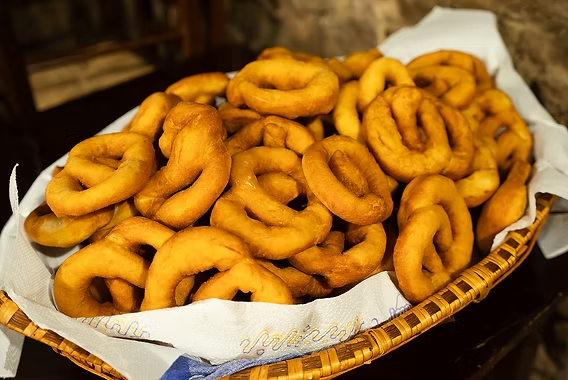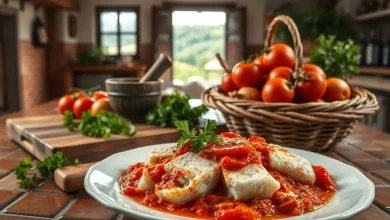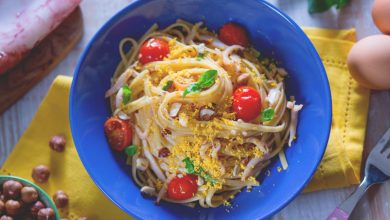Homemade Bread Dough Recipe (Pasta per il Pane)
This versatile bread dough recipe is perfect for those who love the rewarding process of making bread from scratch. With a combination of Manitoba flour and all-purpose flour, this dough has a soft yet firm texture that results in a wonderfully airy loaf. Whether you’re baking bread for a family dinner or planning to make sandwiches, this recipe will yield a rustic and flavorful result. Read on for a step-by-step guide on how to create this delicious bread dough at home, ideal for beginners and experienced bakers alike.
Ingredients
| Ingredient | Quantity |
|---|---|
| Manitoba flour | 150g |
| All-purpose flour (00) | 350g |
| Water | 350g |
| Fresh brewer’s yeast | 7g |
| Fine salt | 8g |
| Malt (optional) | 1 teaspoon |
Nutritional Information (per serving)
| Nutrient | Amount |
|---|---|
| Calories | 260 kcal |
| Carbohydrates | 50g |
| Protein | 8g |
| Fat | 1g |
| Fiber | 2g |
| Sodium | 300mg |
Preparation Instructions
-
Dissolve the Yeast:
Start by dissolving the fresh brewer’s yeast in the room-temperature water. Ensure that the water is not too hot, as this could kill the yeast and prevent the dough from rising properly. Stir the mixture until the yeast is fully dissolved.Related Articles -
Combine the Flours:
In a large mixing bowl, combine the Manitoba flour and all-purpose flour. Mix them together evenly so that the flour is well blended before you add the water mixture. -
Add Water Gradually:
Begin adding the water, starting with about half of it. Pour the water in gradually while stirring the flour mixture with one hand. This method ensures that the dough begins to form slowly and evenly. Once the first batch of water has been absorbed, add the remaining water slowly, continuing to mix with your hand. -
Incorporate the Salt:
Once the dough begins to come together, add the fine salt. Knead the dough for a few minutes to incorporate the salt evenly. Continue kneading the dough, adding the remaining water, until all the water has been absorbed, and the dough feels smooth and elastic. -
Knead the Dough:
Knead the dough by hand for about 10 minutes inside the bowl. This process helps the dough develop the gluten, creating a nice texture. If you prefer to use a stand mixer with a dough hook, start on a medium speed and gradually increase to higher speed as the dough begins to come together. The goal is to get a smooth, elastic dough that isn’t too sticky. -
Let the Dough Rest:
Once the dough has been kneaded, let it rest for 10 minutes. It does not need to be covered. This resting period allows the gluten to relax, making it easier to shape the dough later. -
Shape the Dough:
After resting, transfer the dough onto a lightly floured surface. Using a bench scraper (or your hands), fold two of the four edges of the dough toward the center. Then, fold the remaining two edges toward the center. This process helps shape the dough into a compact form. -
Pre-Shaping (Pirlatura):
Begin shaping the dough into a round ball. To do this, rotate the dough with your hands on the counter. This step, known as “pirlatura,” helps develop tension in the dough’s surface, resulting in a smooth and tight ball. -
Final Proofing:
Place the shaped dough into a lightly floured bowl and cover it with plastic wrap or a damp towel. If the temperature is warm, you can leave it at room temperature. For colder environments (like winter), it’s a good idea to place the bowl in a turned-off oven with just the light on. Let the dough proof for 1-2 hours, or until it has doubled in size. -
Shape and Score the Dough:
Once the dough has doubled in size, remove it from the bowl and place it back onto a lightly floured work surface. Flip it upside down to maintain the shape. Perform another round of pirlatura if needed, forming the dough into a tight ball. Transfer it onto a floured baking sheet. Using a sharp knife or a bread lame, score the top of the dough with a few shallow cuts to create a decorative pattern. These cuts help the bread expand evenly as it bakes. -
Preheat the Oven:
Preheat your oven to 250°C (480°F) on the static setting. Place a small heatproof dish filled with water on the lower rack of the oven. This will create steam during the baking process, helping the bread develop a crisp, golden crust. -
Bake the Bread:
Once the oven has reached the desired temperature, place the bread on the center rack of the oven. Immediately reduce the oven temperature to 230°C (445°F) and bake for 20 minutes. After 20 minutes, remove the water dish from the oven and lower the temperature to 180°C (355°F). Continue baking for another 35 minutes, checking for a golden-brown crust. -
Cool and Serve:
When the bread is done, remove it from the oven and allow it to cool on a wire rack. It’s important to let the bread cool for at least 15 minutes before slicing. This allows the crumb to set and prevents the bread from becoming too doughy when cut.
Tips for Success:
- Yeast Activation: If you’re using dry yeast, activate it in warm water (about 37°C/98°F) along with a pinch of sugar. Let it sit for 10 minutes until it bubbles before proceeding with the recipe.
- Steam for a Crusty Loaf: The steam created by the water in the oven helps to form a crispy, golden crust. If you don’t have a heatproof dish, you can also spritz the inside of the oven with water using a spray bottle just before closing the oven door.
- Flour Variations: For different textures and flavors, you can experiment with various flours like whole wheat or spelt. Keep in mind that using these flours may slightly alter the amount of water required.
- Storage: Store any leftover bread in a paper bag or wrapped in a clean kitchen towel. To keep the bread fresh for a longer period, you can freeze it and reheat it in the oven for a few minutes when needed.
This recipe makes a wonderfully rustic bread dough that you can bake in a variety of shapes or use to create different types of bread. Whether you’re making a traditional loaf or a more creative bread recipe, this dough provides a solid foundation. The process of kneading and scoring the dough, combined with the right baking conditions, will yield a crusty, flavorful loaf that’s perfect for any meal. Enjoy this homemade bread as part of a family gathering, picnic, or simply with a slather of butter and your favorite jam!






